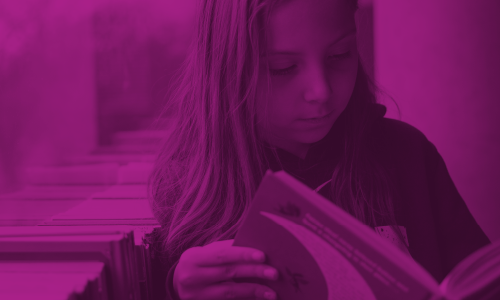
Reading fluency in middle school isn’t always a given. A startling number of students enter those grades without the reading skills they need to be successful. For some, the troubling trend can even continue into high school and college. To help address this, we at NWEA have partnered with the Advanced Education Research and Development Fund (AERDF) to better tackle the problem. Our goal? To support you in helping older students gain the reading skills they need by sharing our research on reading fluency strategies for middle school and above.
Our “Fluency protocol for upper grades” can help you plan fluency instruction for kids as young as grade 6. But first, some information on how we arrived at the protocol in the first place and why we think it can help you and your students.
The who
For the past year and a half, we have been working with AERDF to explore ways to solve the problem of students arriving in middle school unable to read fluently. Tim Rasinski defined “fluency” as “the ability to read the words on the printed page accurately, effortlessly, or automatically so that readers can preserve their limited cognitive resources for the more important task in reading—comprehension—and with appropriate prosody or expression so as to give meaning to the words that is implied through emphasis, phrasing, and intonation.”
We are one of four grant recipients from across the country who were invited to help further the vision of the AERDF Reading Reimagined program: “an American education system in which all students are equipped with the knowledge, skills, and beliefs necessary to be proficient readers, thus enabling them to advocate for themselves, their families, and their communities as they lead lives of limitless opportunity.” AERDF charged us with creating an effective instructional tool that could be used to improve word recognition, fluency, and comprehension. The tool had to meet the following conditions:
- Based on research
- Ready for teachers to use immediately (so, without time-consuming training)
- Designed to encourage student input and engagement during lessons
- Targeted to meet the specific needs of kids most impacted by inequities due to poverty or race
We were fortunate enough to find a willing partner for this work in Gwinnett County School District, in Atlanta, Georgia. They allowed us to work with three grade 6 classrooms and a total of 70 students in one of their middle schools.
The why
Given the many challenges facing education following COVID-19 school closures, why did AERDF and NWEA choose to focus on reading fluency strategies for middle school and above? Because we knew that reading fluency was a problem since before the pandemic.
National Assessment of Education Progress (NAEP) data from 2019 revealed that only 32% of eighth-graders were performing at or above “proficient” in reading; that is, only 32% of eighth-grade students nationwide had the reading fluency skills required for success in college or the workforce. NAEP data also revealed that students from historically marginalized populations scored even lower than their white counterparts. These trends were further confirmed when the 2022 NAEP data was released and the organization stated the following: “At eighth grade, the average reading score was lower compared to all previous assessment years going back to 1998 and was not significantly different compared to 1992.” It is clear that the situation continues to worsen and that no progress has been made in improving students’ reading fluency over the past 25 years.
I’d like to clarify that NAEP does not test students on reading fluency. However, research by Nathan Hartzler Clemens et al. has shown that there is a strong correlation between lack of fluency and low reading performance. Clemens and his team make it clear that if students are too focused on decoding words, they will find it harder to understand the meaning of the text they’re reading.
Let me show you what Clemens et al. mean by that. Read the following sentence: “The venture capitalist amalgamated his financial assets in hope of inveigling others to vote for the panacea he propounded.”
It’s quite possible that that sentence contains at least one word that made you stumble—one word that required that you focus solely on the word and sound it out. More than likely, you read the sentence more than once. Chances are you may not feel entirely confident that you understand exactly what the sentence is saying. That is what students in need of reading fluency support encounter every day. And they can’t even begin to think about meaning if they can’t navigate the words.
What happens if the topic of the sentence is something a reader has no interest in in the first place? What if you don’t care about investments or venture capitalists? It’s much harder to motivate yourself to understand the less familiar words, isn’t it? If that happens over and over (you struggle to read something only to discover you don’t care about it), you might become disenfranchised. In some cases, students who don’t get to see themselves in what they read understandably lack the passion they need to persevere with challenging reading material.
The final factor that elevates the importance of addressing reading fluency in middle and high school is that secondary teacher preparation programs often do not focus on the skills needed to improve fluency. As Graham Drake and Kate Wash explain in “2020 teacher prep review: Program performance in early reading instruction,” that is an area of focus usually limited to elementary programs. Combine that shortcoming in teacher preparation programs with the fact that secondary teachers might have almost 70% of their students reading below grade level and you can begin to see how serious the issue of addressing reading fluency in middle and high school is and why it became the heart of our study.
The study
At the start of this effort, we hypothesized that the effective intervention strategy of repeated reading could be even more powerful if combined with additional components of daily study at the word and sentence level, as well as a focus on student engagement.
Our experimental solution was to create and test a new fluency protocol modeled after one designed by Student Achievement Partners to support teachers using small groups for reading interventions. Our “Fluency protocol for upper grades” consists of the following:
- Five 20-minute sessions
- Whole-class and small-group work
- Repeated reading exercises
- Several minutes of strategy work in the first four sessions
- A reflection activity in the fifth session
Remember that we were also interested in getting students to buy in and become highly motivated to improve their reading fluency skills, so before we had kids follow the protocol, we asked their teachers to do some aspirational work with their class. Students were supported in discussing the definition of “fluency” and why being a fluent reader was important to them. They also rated their reading ability on a 0–10 scale, explained their reading strengths and challenges, and set goals, both for what they hoped to accomplish during the study and what they hoped to achieve in life.
To help students identify with and enjoy what they were reading, we provided a set of 20 grade-level texts and asked each class to vote for the six they wanted to work with over the course of the six-week study. We chose texts we deemed relevant for historically marginalized populations, kids living in poverty, and the average middle school student. We gave teachers definitions of words we predicted students would struggle with, along with a preselected “juicy sentence” to use for Session 4.
Because we didn’t want the protocol to depend on lengthy teacher training, we only explained the juicy sentence analysis from Session 4 during our teacher training prior to beginning the study. This took 20 minutes. We also gave teachers two 15-minute mini-lessons to do with their students at the start of the study. Our hope was that the rest of the protocol was self-explanatory.
The results
So, what did we find? Spoiler alert: We may be onto something good!
We gathered two types of data: quantitative (involving numbers) and qualitative (involving teacher feedback). Let’s look at the numbers first.
The quantitative data
The way we determined whether the protocol impacted student outcomes for reading fluency was to administer a pre-test prior to starting any work with them. We then administered a post-test the day after the last session of Week 6, and a lagged test eight weeks later to see if the learning stuck. The assessments measured word recognition and decoding, vocabulary, morphology, sentence processing, silent reading fluency, and reading comprehension. Because the goal of the protocol was to increase fluency, we were most interested in the silent reading fluency scores.
The data told us that for students who scored above the 50th percentile on the post-test, the protocol did not improve fluency. In fact, the scores went down when compared to the pre-test. (I’ll talk about potential reasons why in the qualitative section.) However, for students who scored below the 50th percentile, there was a statistically significant difference, with students showing improved fluency, and most of that improvement lasting for the eight weeks post instruction.
To summarize: the data showed us that the fluency protocol may be most effective when used as an intervention with students who are not fluent, rather than as a tool with a class of mixed fluency levels. It’s important to note, of course, that studies like this should be replicated to see if the results stay consistent before making firm decisions about effectiveness. But we were excited by this early data.
The qualitative data
We wanted to know, from the teachers’ observations and interactions with the students over the course of the study, how they thought things went. And, remember: we wanted to know what happened when students were bought in. Did the goal setting, weekly reflections, and voting for relevant passages seem to promote student engagement? (We did have a quantitative assessment we used to ask students directly, but upon later examination, we realized it didn’t really fit the needs of the study, so the results were not helpful.) We interviewed the teachers about the protocol and the process, and some trends emerged:
- For students who previously struggled to read fluently and lacked confidence, the teachers felt the protocol had a positive impact on both the students’ reading abilities and how they felt about reading in general. (The quantitative data described previously seems to support this observation.)
- Teachers believed that the most impactful practice used in the protocol was repeated reading, which required students to read a passage aloud several times.
- We also heard that the protocol was easy to use with minimal training. The teachers said they’d continue to use it in the future with students who need intervention.
- Teachers noted that it was difficult to get higher-achieving students engaged in the work, as those students felt like they were already fluent or had already mastered the word- and sentence-level strategies. (Again, the quantitative data seems to support this observation.)
- Teachers mentioned that it was challenging to find time to fit the protocol work in with the normal demands of the classroom.
Looking forward
Although our study on reading fluency strategies for middle school focused on a smaller sample size of approximately 70 sixth-grade students, we are encouraged by the findings about the impact of the process and the protocol on the students who are struggling readers.
But research can be a bit like the book If You Give a Mouse a Cookie by Laura Numeroff: one answer can then lead to another question, which leads to another question, which leads to yet another question. We still have wonderings about what the best application of the protocol is to allow for use with the right students without impacting classroom time for all. And we’d love to have a chance to compare the outcomes of students who practiced repeated reading only to those who practiced repeated reading plus the word- and sentence-level strategies so we can see how the results of the two approaches differ. We’re also curious to explore whether students are able stay engaged if a protocol is used with texts from their normal curriculum in their ELA classes, or even in their science or social studies classes.
Maybe one day we will have the opportunity to explore our lingering questions, or maybe someone else will pick up the gauntlet and run with it. In the meantime, we are heartened by the fact that many student participants benefitted from the study and improved their reading fluency. We feel confident that the reading fluency strategies for middle school and higher included in our protocol can be a valuable tool for teachers to add to their toolbox.
If you’d like to read more about the work, you can access the full report on our website.




